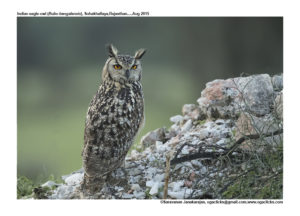
Indian Eagle Owl Bubo bengalensis
Etymology:
- Bubo : Latin word for Eurasian Eagle owl
- Bengalensis : From Bengal in India
Vernacular Names :Baluchistan: Boom, Sind: Gug, Hindi: Ghughu, Pun: Kanarulloo, Ben: Hutompecha, Ladakh: Oog-pa, Guj: Moto ghuvad, Mar: HumaGhubad, Shrungighubad, Ta: Kombanaandai, Te: Yerragudlaguba, Mal: Kombanmunga, Hindi:Ghuggu
Distribution in India: Wide spread resident of Himalayan foot hills and below in India
Description:Size of 50–56 cm, wt.1100 g, wing span of 350-430 cm. It is a large, dark brown owl with prominent ear-tufts. It has darker and more tawny-buff coloration with black mottling and streaking, ,less heavy streaking below. The irides are deep yellow to orange-red, cere is greyish,bill is greenish-horn to slaty-black, talons are dusky-black. It has dark and light morphs, former having darker ground colour with fewer light spots above. Juvenile lacks ear-tufts, obscurely barred on head, mantle and underparts, and have paler eyes.
Habitat: It is found in rocky hills and wooded country with scrub, ravines, old mango plantations, groves with aged trees, tropical thorn and sal, and rocky semi-desert with thorn scrub, ruins. It is found from lowlands up to 2400 m.
Food habit: It eats small mammals like rodents, birds to size of peafowl, lizards, snakes, frogs, fish, crabs and large insects. It is largely nocturnal, but often perches on rock pinnacle or other vantage point well before sunset and after sunrise. It hunts by gliding from perch on to prey, sometimes makes searching flights. They also wade in water to catch frogs.
Breeding habits: They breed in Oct–May in India. They have no nest and lay eggs on bare soil in saucer-like scrape created by both sexes, on rock ledge or recess in cliff or on ground under tree or bush. They lay a clutch of 3–4 eggs. The incubation is done from first egg by female and fed by male. The incubation period is period 33–35 days. The young hatch asynchronously.